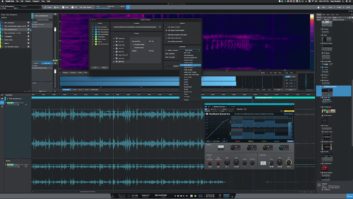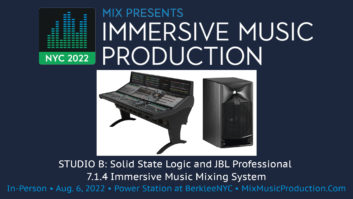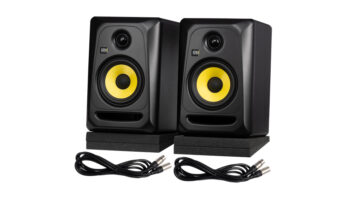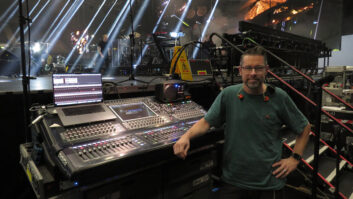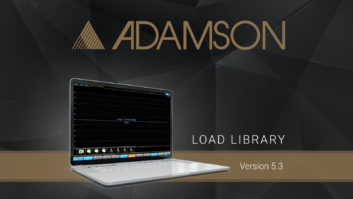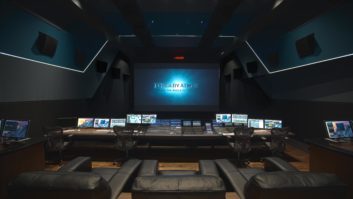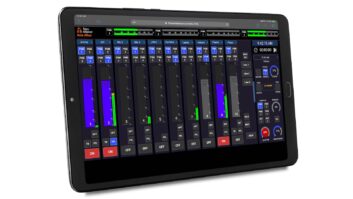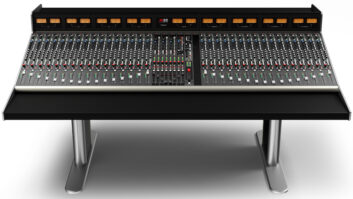The fact that Euphonix has been developing a digital console is no secret. In fact, the company first announced its plans to build a digital mixer in the November 1997 issue of Mix. The article stated that Euphonix digital consoles would offer 24-bit analog and digital interfacing, 40-bit floating-point internal processing and 96kHz capability, in a scalable, modular and field upgradeable package. Now, at AES, Euphonix will finally unveil its System 5, a no-compromise digital console that supports from 48 to 200+ channels and meets all the design criteria the company spelled out nearly two years ago.
“We consider System 5 to be a high-performance digital console right from the start,” says Euphonix founder Scott Silfvast, “because of the amount of control power we have put in the surface, coupled with more buses, more channels, more surround capability, more control of dynamics, more modularity, more reliability and 96kHz capability. And it will be working from the day everyone first sees it at AES.” A System 5 production model has been in daily operation for months at San Francisco post studio One Union, and five more consoles were slated to ship in the weeks before AES.
Essentially, System 5-it’s the company’s fifth console product-consists of a control surface, the digital mixing core (with all the processing, control, synchronization, routing and DSP) and rackmount audio interfaces providing any desired combination of analog and digital I/O.
The control surface comprises a master fader, a communications/talkback panel, source monitor select, control-room playback (for mains and two sets of alternative speakers), automation control, solo master controls (APL, PFL and solo in-place), transport and locate facilities with jog/shuttle wheel, preset and user-definable function keys, monitor A/B/C/D output controls, a panel with 34 keys (each with eight-character displays) for enabling master functions and an assignable central strip. Identical in appearance to any channel strip, the central strip can be assigned instantly to provide control of any input channel. For example, if the user wants to EQ a snare on channel 2, all controls for that channel can be accessed either from the center section or from the channel itself.
MODULAR, EXPANDABLE, FLEXIBLE
The channel strips come in 8-channel buckets, each with eight strips and a high-resolution active-matrix TFT screen that simultaneously shows the name and status for each of the channels, along with large, bright peak-type metering, gain reduction metering (for the onboard dynamics), and EQ or compressor curves. Each channel fader-bucket is essentially a self-contained unit with built-in computer, display screen and tactile controller, connecting to the frame via a power and network connector. And besides being hot-swappable, this no-backplace/no-edgecard design brings the possibility of easily designing a customized console housing, or creating articulated, sidecar or winged versions.
“It’s a very modular system, and because of that, there’s no ‘master computer’ or ‘master power supply’ or other single big component that could bring the system down,” says Silfvast. “We admit to Murphy’s Law, saying that something could fail at some time, yet in a distributed modular system, a single component in the system could fail, but the rest of the system keeps running. And that approach means everything in applications such as broadcasting.”
According to Silfvast, this approach also lets a studio manage its resources more efficiently. “For example, if there’s a 48-fader frame in one room and 24 faders in another room, you can literally move these fader buckets to the other room, drop them in and have a lot more flexibility in your investment,” he explains. “And the same is true with the DSP cards and the I/O converter boxes. So if one room doesn’t need analog I/O one day and the other studio needs more, just move them around. On the lower end, it allows studios to start out small and grow the systems as their needs and finances expand.”
Not coincidentally, Euphonix is also unveiling the 24-bit/96kHz version of its R-1 disk-based multitrack recorder at AES, adding 48-track and 96kHz capability. “With System 5’s 96kHz software in place, the console surface behaves exactly the same, but you get half the number of channels,” Silfvast says. “A music studio may buy a console that’s 200 channels at 48 kHz or 100 channels at 96 kHz, providing a way that System 5 owners can differentiate themselves from competing studios with other digital consoles. We wouldn’t launch a 96kHz console without having a 96kHz multitrack available, and a 96kHz recorder is great with analog consoles as well. Also, our multitrack is not buried inside the console-they connect via a single MADI cable, and can be used separately as well.”
COMING TO THE SURFACE
Having shipped more than 500 digitally controlled analog consoles, Euphonix has learned quite a bit about creating control surfaces for mixers. “A console is not only an extension of the person using it,” says Silfvast, “but that surface must be one part control and five parts feedback, and be able to show the user what is happening globally-not just one channel at a time.”
A key element in reaching that goal was developing a patent-pending “digital knob,” a rotary encoder that shows the relative position of the knob via an LED ring. However, unlike similar-looking encoders, the LEDs are built into the top of the knob. This approach prevents the knob from visually blocking the knob pointer when scanning across the entire surface from many different angles. Additionally, there’s push-switch built into the knob for entering automation modes, etc. The knob is surrounded by a “tire” outer surface that’s removable and could be painted, or molded with various hues for color coded-functions.
The key to creating a successful user interface is offering something people will use, rather than taking unfamiliar approaches such as light-pen control or virtual gloves. “We think we’ve got a revolutionary control surface,” says Silfvast of the System 5. “And by that, I mean somebody can walk up to it and ten minutes later decide that they can do a session and be comfortable working on it. Our CS-3000 was never intended to be that way, ’cause it’s a ‘sit-down-and-learn-this-thing-and-it-will-extend-your-power’ kind of surface. The whole point of the System 5 is to NOT be different, but to look and feel friendly and deliver what somebody asks of it.”
RIGHT AT THE CORE
The central digital mixer core-mounts in one to four rack frames (which can be placed in a machine room), providing from 48 to 200+ channels. The DSP cards are based around second-generation SHARC processors. According to Silfvast, a scalable architecture is formed where the console is expanded simply by adding more DSP cards. “There’s lots of dedicated power-there’s no dynamic allocation of DSP resources-there’s none of this ‘grab a mouse and pull an EQ out of a resource pool.’ And now, processing power has gotten cheap enough that at some point, it cost more to make the DSP assignable than it did to just put a bunch of parallel DSP cards in there. We took that approach of making the console totally programmable. It’s nothing like the approach of an ASIC-based console, where you have a 48kHz, 4-band digital EQ and the console will always be that way, because its design and feature set is fixed in the hardware. So if we decide we want a multiband dynamics tool to replace the EQ and dynamics on a channel, it’s on software you can get from us.”
The system communicates via EuCon, a high-speed, real-time control network that links the console and computers to a central switching hub. But beyond that definition, EuCon allows the distribution of the operating system over numerous computers, so that the individual computers (one is located inside each fader-bucket, and one for each DSP frame) behave as a single large computer.
INTERFACE: CHOICES, CHOICES…
I/O interface options for System 5 are numerous, based on Euphonix’s existing line of rackmount devices, so the user can choose from that line or use their own converter sets du jour. Among the Euphonix line are its 26 channel ADCs and DACs, MADI/analog and analog/MADI converters, and AES/MADI and MADI/AES converters. A matching audio monitor interface provides I/O to all the control room monitoring and talkback functions. As an option, additional I/O interfaces can be located in the control room for short-run connection of outboard gear, instrument patching, etc. And the Euphonix ML130 features 24 remote mic/line preamps, with fingertip console control of input gain, phase, phantom powering, delay and line/mic switching.
SOME BASICS
In addition to the previously mentioned compressor/limiter/expander and delay on every channel, each System 5 channel also features 4-band true parametric EQ, 20-20k highpass/lowpass/bandpass filters, four-character scribble strip naming of channels and AFL/PFL/solo in-place.
The moving fader and every-function-reset automation offers both dynamic and SnapShot Recall modes, with extensive editing/merge/trim/offset and preview functions. The machine control panel in the master section has a large wheel with jog/shuttle functions (and an LED array “speedometer” indicating the relative rate of forward/backward motion), along with standard recorder-type transport keys, dual LED timecode displays, programmable locator points (99 cues available in each title) and user-definable preroll/postroll/rollback. In keeping with its EuCon distributed intelligence networking, many of System 5’s lesser-accessed features are handled by an external PC running eMix management software. Essentially, eMix handles functions such as the digital patch bay, project titles, disk directories and backups.
Borrowing from the innovations in the CS-3000, the flexibility in the stereo and multiformat panning is impressive, offering independent front and surround control of divergence and focus as well as control of the X-Y axes via pan, surround and rear pan knobs in each channel’s knob strip or by using the trackball. Either way, entering pan mode immediately brings a visual panner display into the master section and into the TFT screen above each channel. The console supports all standard formats (mono, stereo, LCR, LCRS, 5.1, 7.1) to a max of 16 multiformat surround stems, each with up to eight buses; also, a single control can pan to several stems simultaneously with different formats.
PRICING
The Euphonix System 5 will be officially unveiled to the public on the first day of AES-and it will be available, not vaporware. Pricing is said to be competitive with digital desks such as the SSL MT, Sony Oxford or AMS Neve Logic. If you’re in the market for a high-end digital board, check it out.
Euphonix, 220 Portage St., Palo Alto, CA 94306; 650/855-0400; fax 650/855-0410; www.euphonix.com.
